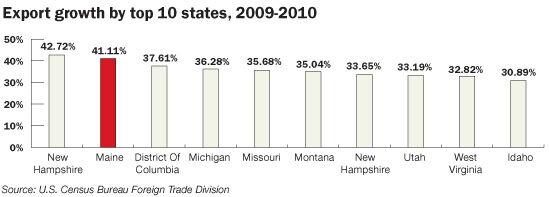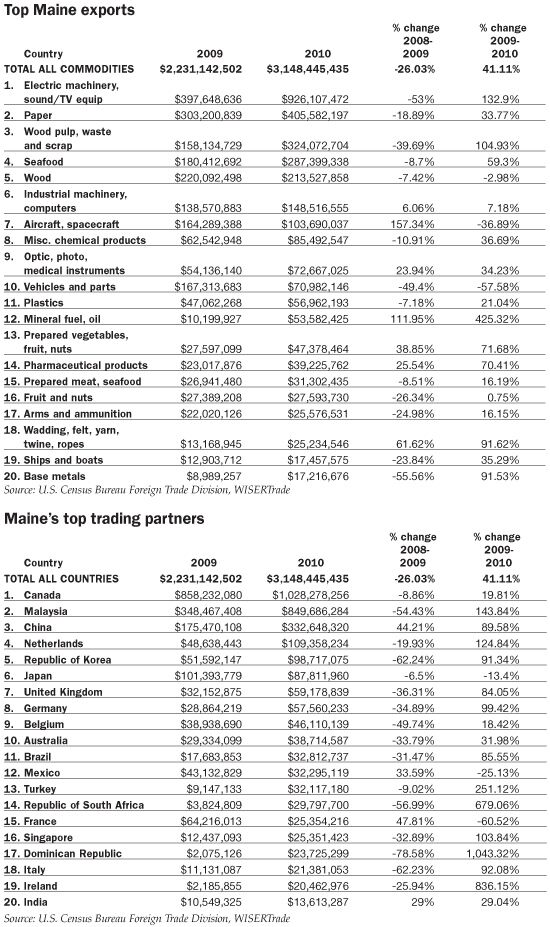Processing Your Payment
Please do not leave this page until complete. This can take a few moments.
- News
-
Editions
View Digital Editions
Biweekly Issues
- December 1, 2025
- Nov. 17, 2025
- November 03, 2025
- October 20, 2025
- October 6, 2025
- September 22, 2025
- + More
Special Editions
- Lists
- Viewpoints
-
Our Events
Event Info
Award Honorees
- Calendar
- Biz Marketplace
Trading up: After a bleak 2009, Maine exports set an all-time record


Maine companies recorded their strongest year ever in sales to foreign countries in 2010, thanks to booming consumption of products at opposite ends of the technological spectrum: paper and iPads.
Sales by Maine companies to international markets totaled $3.15 billion last year, topping the previous export record of $3.02 billion set in 2008, according to the Maine International Trade Center. Underlying much of the growth were gains in the wood pulp and paper industry, up 105% and 34%, respectively, and even stronger sales of semiconductors, used in mobile devices and tablet computers, which spiked 133%.
Overall, Maine’s exports climbed 41% over a dismal 2009, when worldwide trade dropped precipitously amid global economic turmoil. But even though last year’s bleak performance contributed to higher percentage gains for many states this year, Maine still outperformed, coming in second only to New Hampshire in export growth by dollar value. The national average of 21% was roughly half of Maine’s rate, points out Janine Bisaillon-Cary, president of the Maine International Trade Center. “I feel like we took a huge jump last year compared to the national average,” she says. In mid-2010, MITC predicted more modest growth of 20% to 25%. “We didn’t anticipate this jump,” Bisaillon-Cary says. Over the last five years, Maine exports have risen 19%.
A weak American dollar in the latter half of 2010 made exports from Maine and other states much more attractive to international buyers, particularly in Canada, China and Japan. The Chinese continue to expand their paper-making capacity, buying up pulp from Maine for domestic production, says John Williams, president of the Maine Pulp and Paper Association. The former Domtar mill in Baileyville, which Hong Kong investment group International Grand Investment Corp. scooped up last October, today sends most of its pulp overseas, Williams says. The same is true for much of Old Town Fuel & Fiber’s pulp. “We’ll be exporting more and other countries may be sending more in our direction,” he says. The overall economic rebound has also boosted sales of coated paper used in magazines and advertisements.
Healthy demand for semiconductors in countries such as Malaysia continued in 2010 as well. The industry has undergone a bit of a shakeup in Maine this year, with Fairchild Semiconductor moving its corporate headquarters from South Portland to Silicon Valley to boost its image as a leading technology company. Fairchild plans to maintain its manufacturing operations in Maine, however. Meanwhile, National Semiconductor was acquired earlier this month by rival Texas Instruments for $6.5 billion. Dallas-based Texas Instruments will continue to operate the company’s manufacturing plant in South Portland, as well as plants in Scotland and Malaysia, according to a press release.
Other commodities that shored up Maine’s strong trade performance last year include our perhaps most iconic export: lobster. Sales of the crustaceans to Italy, the U.K., Spain and Asia buoyed a 59% rise in seafood exports, Maine’s fourth-largest export, to $287 million last year. Boatbuilding also enjoyed a strong year, with demand for luxury items recovering internationally.
As for emerging sectors, sales of pharmaceutical and biotech products climbed 70% last year, largely driven by Westbrook’s Idexx, while medical product exports rose 34%. Portland’s Lighthouse Imaging Corp., which develops medical optical devices such as endoscopes, has sold its products in Germany for years and operates a distribution center in Hong Kong, but it’s now in the process of setting up a worldwide distribution network and plans to open an office in Germany this summer, according to CEO Mark Waite. Exports make up 20% of the company’s sales, a figure that’s certain to rise, he says. “The flow is kind of going in the other direction, which is nice to see, isn’t it?” Waite says.
As for whether Maine companies really stepped up their game in 2010 or existing exporters merely benefited from improving international markets, it’s tough to say, according to Bisaillon-Cary. But MITC received nearly 1,300 requests from companies for trade assistance and consulting in 2010, a figure that’s ballooned 400% since early 2000, she says. While Maine companies are clearly more active, “If the market is flat or going down, it doesn’t matter how innovative you are, it’s going to be a challenge,” she says.
After a grim 2009 and an unexpectedly robust 2010, prospects for Maine exports remain strong with rebounding international markets and a favorable exchange rate, Bisaillon-Cary says. So far in 2011, the semiconductor and aircraft industries look to be leading Maine’s export charge.
Jackie Farwell, Mainebiz senior writer, can be reached at jfarwell@mainebiz.biz.
Top Maine export in 2010 to:
Canada: Seafood, mostly lobster
China: Wood pulp
Malaysia: Semiconductors
Korea: Chemicals used in electronics
Netherlands: Medical/optical instruments
Mainebiz web partners

The Giving Guide
The Giving Guide helps nonprofits have the opportunity to showcase and differentiate their organizations so that businesses better understand how they can contribute to a nonprofit’s mission and work.
Learn More
Work for ME
Work for ME is a workforce development tool to help Maine’s employers target Maine’s emerging workforce. Work for ME highlights each industry, its impact on Maine’s economy, the jobs available to entry-level workers, the training and education needed to get a career started.
Learn More
Groundbreaking Maine
Whether you’re a developer, financer, architect, or industry enthusiast, Groundbreaking Maine is crafted to be your go-to source for valuable insights in Maine’s real estate and construction community.
Learn more-
The Giving Guide
The Giving Guide helps nonprofits have the opportunity to showcase and differentiate their organizations so that businesses better understand how they can contribute to a nonprofit’s mission and work.
-
Work for ME
Work for ME is a workforce development tool to help Maine’s employers target Maine’s emerging workforce. Work for ME highlights each industry, its impact on Maine’s economy, the jobs available to entry-level workers, the training and education needed to get a career started.
-
Groundbreaking Maine
Whether you’re a developer, financer, architect, or industry enthusiast, Groundbreaking Maine is crafted to be your go-to source for valuable insights in Maine’s real estate and construction community.
ABOUT
NEW ENGLAND BUSINESS MEDIA SITES
No articles left
Get access now
In order to use this feature, we need some information from you. You can also login or register for a free account.
By clicking submit you are agreeing to our cookie usage and Privacy Policy
Already have an account? Login
Already have an account? Login
Want to create an account? Register
Get access now
In order to use this feature, we need some information from you. You can also login or register for a free account.
By clicking submit you are agreeing to our cookie usage and Privacy Policy
Already have an account? Login
Already have an account? Login
Want to create an account? Register







Comments